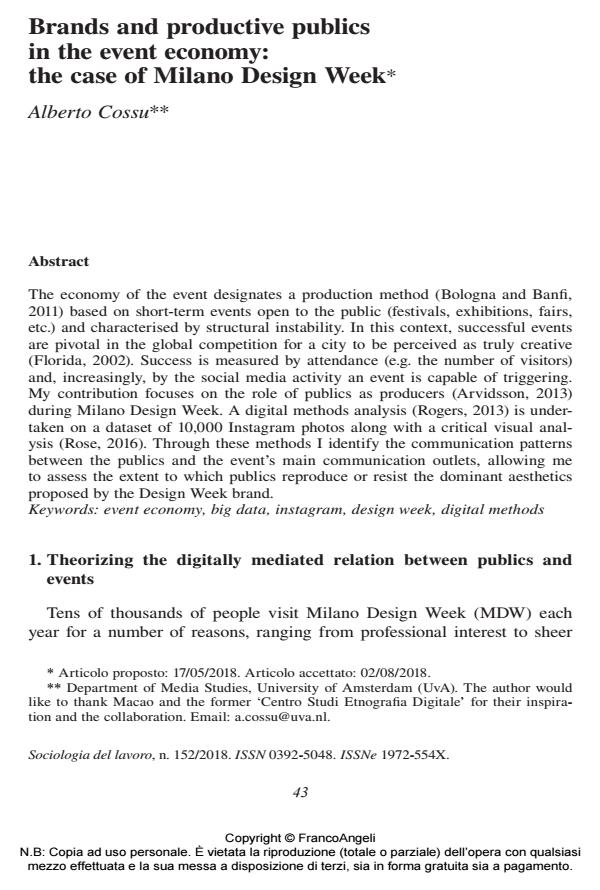Brands and productive publics in the event economy: the case of Milano Design Week
Titolo Rivista SOCIOLOGIA DEL LAVORO
Autori/Curatori Alberto Cossu
Anno di pubblicazione 2018 Fascicolo 2018/152
Lingua Inglese Numero pagine 62 P. 43-64 Dimensione file 216 KB
DOI 10.3280/SL2018-152003
Il DOI è il codice a barre della proprietà intellettuale: per saperne di più
clicca qui
Qui sotto puoi vedere in anteprima la prima pagina di questo articolo.
Se questo articolo ti interessa, lo puoi acquistare (e scaricare in formato pdf) seguendo le facili indicazioni per acquistare il download credit. Acquista Download Credits per scaricare questo Articolo in formato PDF

FrancoAngeli è membro della Publishers International Linking Association, Inc (PILA)associazione indipendente e non profit per facilitare (attraverso i servizi tecnologici implementati da CrossRef.org) l’accesso degli studiosi ai contenuti digitali nelle pubblicazioni professionali e scientifiche
The economy of the event designates a production method (Bologna and Banfi, 2011) based on short-term events open to the public (festivals, exhibitions, fairs, etc.) and characterised by structural instability. In this context, successful events are pivotal in the global competition for a city to be perceived as truly creative (Florida, 2002). Success is measured by attendance (e.g. the number of visitors) and, increasingly, by the social media activity an event is capable of triggering. My contribution focuses on the role of publics as producers (Arvidsson, 2013) during Milano Design Week. A digital methods analysis (Rogers, 2013) is under¬taken on a dataset of 10,000 Instagram photos along with a critical visual anal¬ysis (Rose, 2016). Through these methods I identify the communication patterns between the publics and the event’s main communication outlets, allowing me to assess the extent to which publics reproduce or resist the dominant aesthetics proposed by the Design Week brand.
L’economia dell’evento designa un modo di produzione (Bologna e Banfi, 2011) basata su eventi di breve durata aperti al pubblico (festival, mostre, fiere, etc.) caratterizzati da una instabilità strutturale. In questo contesto, gli eventi di successo sono cruciali per la competizione globale delle città al fine di essere annoverate tra quelle genuinamente creative (Florida, 2002). Il successo è misurato dalla partecipazione dei visitatori e, in modo crescente, dalla attività sui social media che è capace di generare. Il presente articolo indaga il ruolo dei pubblici come produttori (Arvidsson, 2013) durante la Milano Design Week. L’analisi è condotta su una base dati di 10,000 foto caricate su Instagram attraverso metodi digitali (Rogers, 2013) e una analisi visiva critica (Rose, 2016). Tramite essi, identifico i modelli di comunicazione che si stabiliscono tra i pubblici dell’evento e i principali canali di comunicazione dell’evento stesso, al fine di verificare fino a che punto i pubblici riproducono, o resistono, i canoni estetici dominanti proposti dal brand ‘Design Week’.
Parole chiave:Economia dell’evento, Big Data, Instagram, Fuorisalone, Digital Methods
Alberto Cossu, Brands and productive publics in the event economy: the case of Milano Design Week in "SOCIOLOGIA DEL LAVORO " 152/2018, pp 43-64, DOI: 10.3280/SL2018-152003